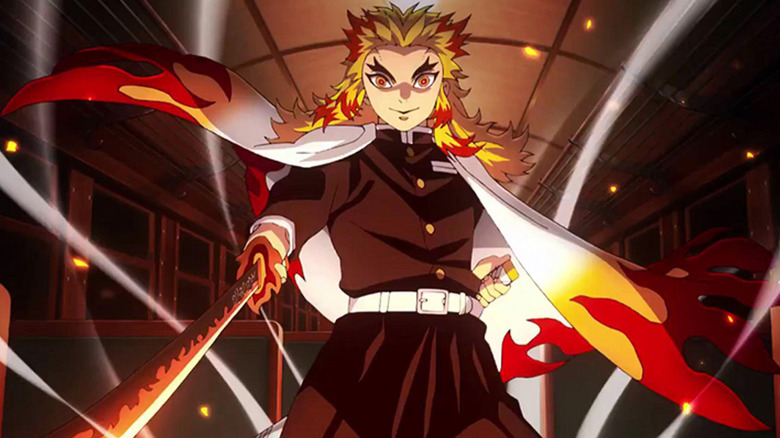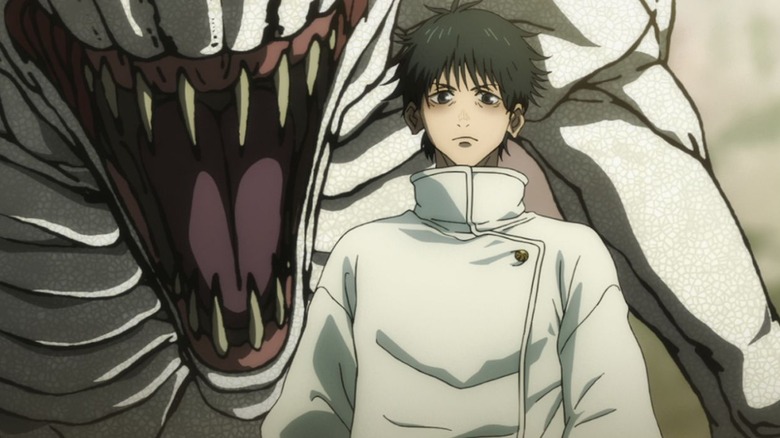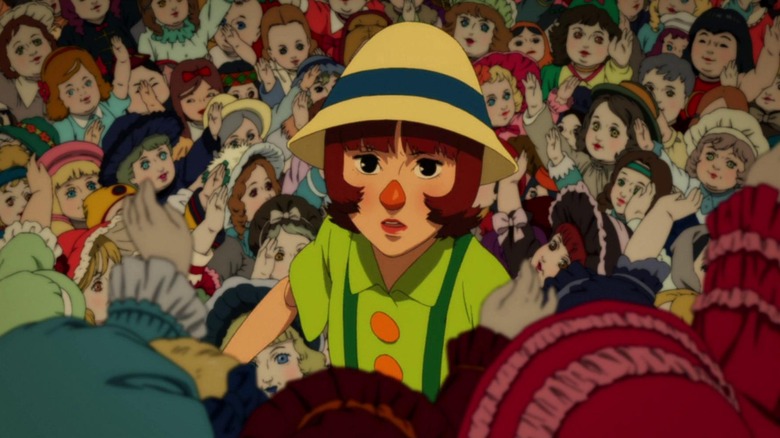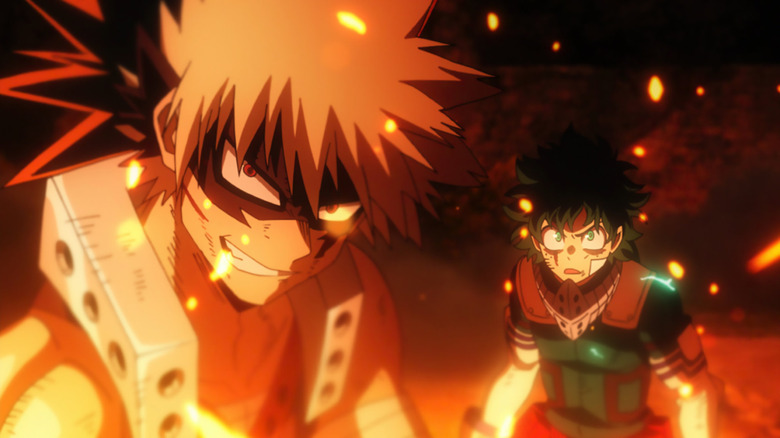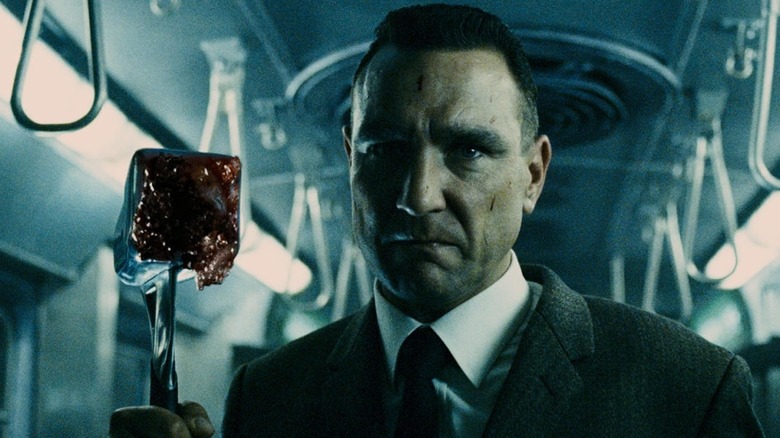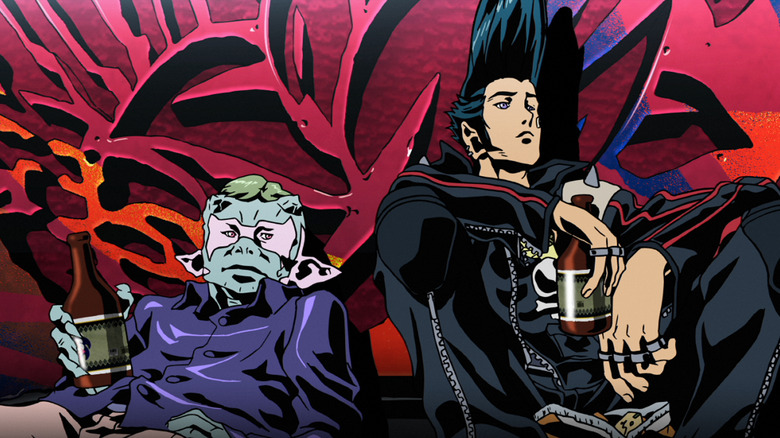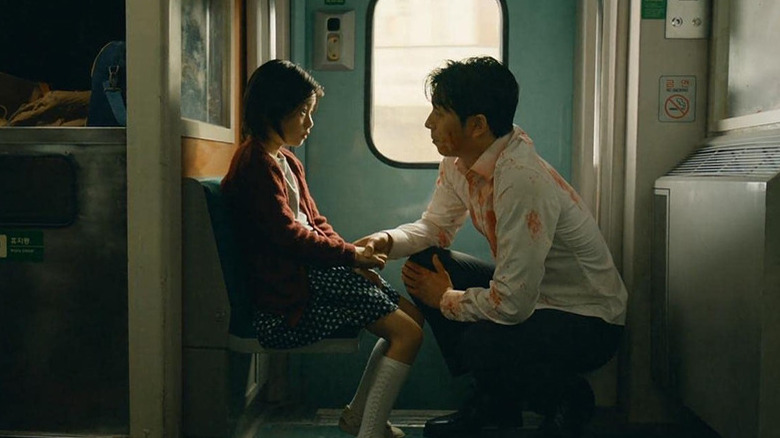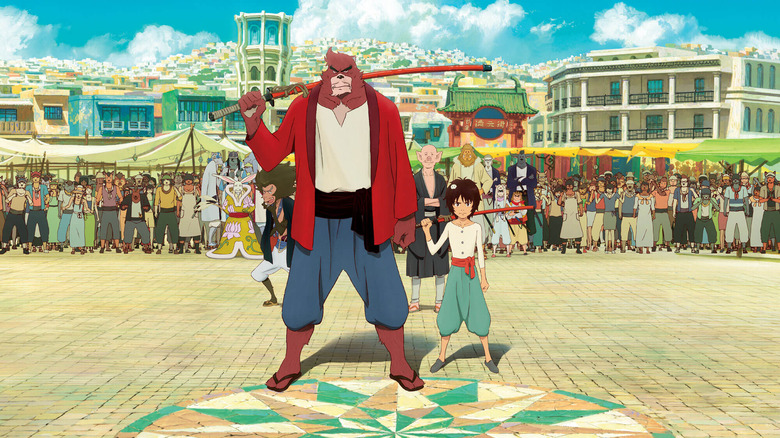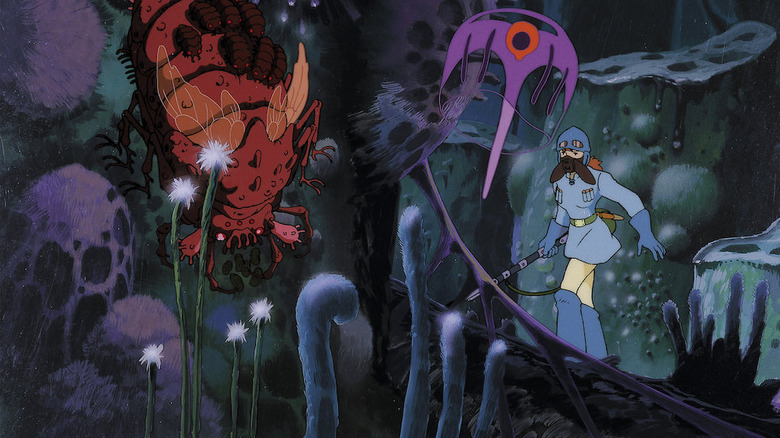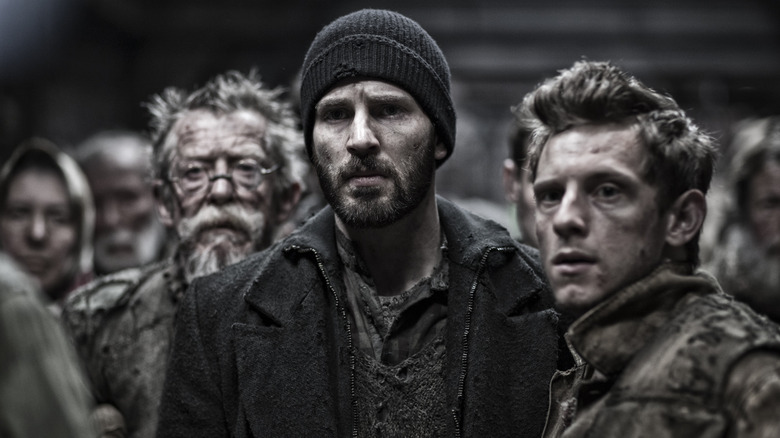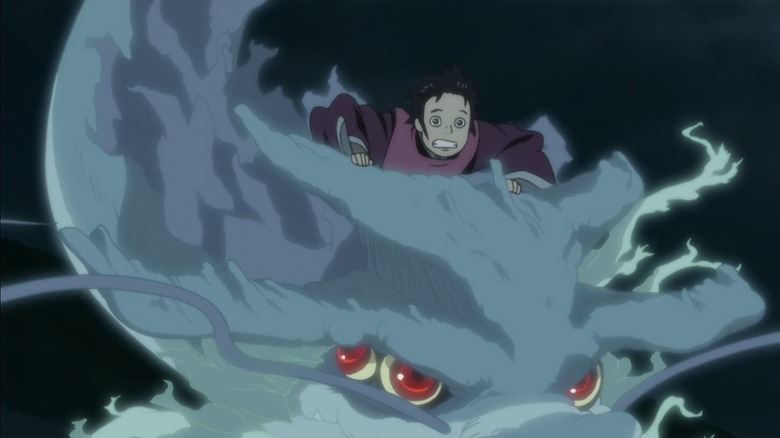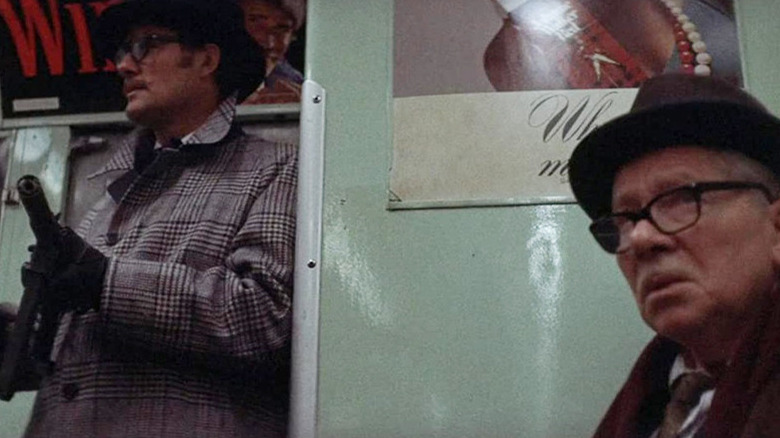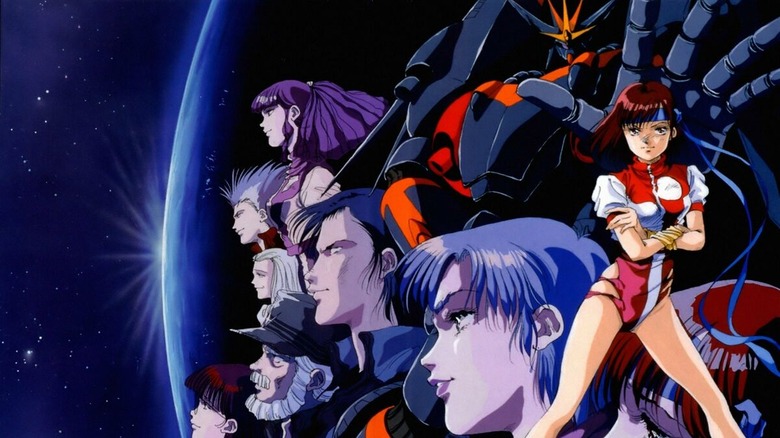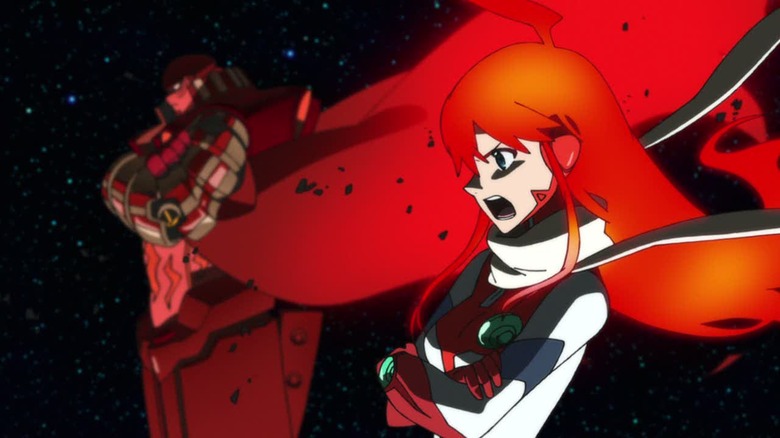13 Movies Like Demon Slayer: Mugen Train That Are Definitely Worth Watching
"Demon Slayer: Kimetsu no Yaiba," or simply "Demon Slayer," is an international sensation. The show, which launched in 2019, quickly gained popularity in Japan and spread like wildfire due to its gorgeous animation, a perfect mix of horror and wholesome, and a cinnamon roll of a main character, Tanjiro Kamado. After its 26-episode run, the Japanese animation studio Ufotable quickly developed a sequel film, titled "Demon Slayer: Mugen Train." It made over $505 million at the worldwide box office and globally became the second highest-grossing film of 2020, on top of becoming the highest-grossing Japanese film of all time — and for good reason.
The movie is impeccably animated, featuring incredible technicolor fight sequences that take your breath away. More than its aesthetics, "Demon Slayer: Mugen Train" is able to deliver touching character beats that make it more than just another action anime; it's full of heart and packs an emotional punch that may just have you in tears at the very end. If you've watched "Demon Slayer: Mugen Train" and are craving more action, emotion, and high-octane battle sequences (or maybe a little touch of horror) in either animated or live-action stories, here are 13 films that may just scratch that itch.
Jujutsu Kaisen 0
Like "Demon Slayer," "Jujutsu Kaisen" is a newer anime series that quickly took the world by storm with its animation and creepy demon design, along with a wholesome yet powerful central character. In the world of "Jujutsu Kaisen," jujutsu sorcerers are tasked with protecting the world from the evil and violent proclivities of demons. Young sorcerers train at the esteemed Jujutsu High to carry on the ancient art.
A prequel film, "Jujutsu Kaisen 0" (based on the manga of the same name), was released in the U.S. in March 2022. It follows the origin story of Yuta Okkotsu, a character only briefly mentioned in the series but said to be extremely powerful. In the film, he's shown as a child with his best friend, Rika. They promise to marry each other when they grow up, but she's tragically hit by a car. Her undying love resurrects her soul as an angry demon connected to Yuta. He's taken under Satoru Gojo's wing to train and learn how to control Rika for good.
What unfolds is not only a tale about grief, but a rather tragic story about a war between the living and the undead, led by a traitorous sorcerer. Don't worry if you haven't watched the series; the film is accessible to both diehard fans and those unfamiliar with the world of demon-hunting sorcerers.
Paprika
The late Satoshi Kon was a cinematic genius. From the trippy TV series "Paranoia Agent" to the harrowing horror story "Perfect Blue," Kon created uniquely gorgeous yet terrifying stories about the dangers of technology and fears of increased human isolation. His magnum opus, and perhaps his most well-known work, is his 2006 film "Paprika," which was his final feature before he died in 2010.
The movie follows a scientist, Dr. Atsuko Chiba, who has helped create a machine called the DC Mini, which allows access into a person's dreams as a kind of psychiatric treatment. In reality, she's an uptight and serious woman, but in the land of dreams, she's known as Paprika, a floating free spirit. When the technology is stolen, someone begins killing people in their dreams and causes the subconscious to seep into reality. Kon packs the film with incredible surrealist imagery that beautifully encapsulates the strange, fleeting nature of dreams and what happens when humans use it as a battleground.
"Paprika" is often cited as a major influence for Christopher Nolan's 2010 film "Inception," which not only deals with a similar subject matter, but also seems to take specific shots from Kon's work. Most notably is the scene where Joseph Gordon-Levitt's Arthur is running on the walls and ceilings of a long hallway. While Nolan has never directly confirmed those claims, critics, such as Ciara Wardlow from Film School Rejects, have analyzed the two and noted their extensive parallels.
My Hero Academia: Heroes Rising
If you're still looking for wholesome yet action-filled anime, then you need to watch "My Hero Academia" and its companion film "My Hero Academia: Heroes Rising." Izuku Midoriya is a teenager who lives in a world where a large part of the population possesses quirks, which are essentially superpowers. They range from the typical invisibility and fire powers to people with frog-like abilities. Anything you can think of exists in this universe.
Midoriya doesn't have a quirk until he meets the number one hero, All For One, who secretly transfers his powers to young Midoriya. Midoriya is accepted to the prestigious quirk school UA and thus begins his journey as a professional hero. The film takes place later in Midoriya and his class' hero education. They all have better honed their powers, fought monsters, and bonded together as a team and family of sorts.
The movie continues to show the love and loyalty between classmates while placing them on the isolated island of Nabu with a dangerous enemy possessing an uncontrollable quirk. Similar to "Mugen Train," the film balances wholesome relationships with gorgeous action sequences that will have you cheering at the screen. ("Heroes Rising" won't reduce you to tears like "Mugen Train," though.)
The Midnight Meat Train
This is the dark horse pick of the list, but I stand by my choice to include this absolutely gnarly Clive Barker adaptation. It stars a then relatively unknown Bradley Cooper as Leon, a photographer who stumbles upon an ancient and depraved secret in the New York City subway. Mahogany (Vinnie Jones) is a butcher and serial killer who, armed with a meat tenderizer, kills unsuspecting victims who are unfortunate enough to end up on his train.
Mahogany isn't just killing for fun, though. He's killing to feed something that lurks in the subterranean depths under the city. Leon is disgusted but intrigued, looking at this as an opportunity to capture a darker side of humanity for his upcoming show. Also, Brooke Shields has a cameo.
While not as family-friendly as "Mugen Train," this is for the horror-inclined folks out there seeking more gory action and something a little more depraved. Since its source material is from the mind of Clive Barker, you can expect a weirdly erotic, blood-splattered tale with a title much funnier than anything shown in the film.
Redline
If you're looking for more absolutely stunning animation, Takeshi Koike's 2009 "Redline" should skyrocket to the top of your watchlist. The film follows JP, a racer on planet Dorothy who competes in deadly races to pay off his debts. When his debts are paid and he can finally leave the racing world, he's urged by fans to take part in the Redline race, the biggest race in the galaxy, which takes place on a planet full of angry cyborgs. It's a recipe for disaster.
While it sounds like there's extensive lore for the film, it's mostly just about its colorful and ridiculous vibes more than anything else. Plus, JP has an absurdly massive pompadour. Think "Space Dandy," but even bigger. It's the macho racing movie ratcheted up to 11 with incredibly well-endowed women and elaborately drawn cars. The movie may have hypersexualized subject matter, but boy, is it fun to look at. "Redline" is comprised of over 100,000 hand-drawn frames, which took seven years for the studio to complete.
Train to Busan
This wouldn't be a list of movies to watch after "Mugen Train" without Yeon Sang-ho's 2016 Korean zombie horror film "Train to Busan." It's both a zombie movie and a tender film about the fractured relationship between a father and his young daughter Soo-an (Su-an Kim). Divorced dad and busy white-collar worker Seok-woo (Gong Yoo) takes his daughter for a weekend and boards a train to, you guessed it, Busan. Little do they know that a zombie virus is quickly starting to spread across the country.
As an infected passenger begins biting and infecting more people, the uninfected must barricade themselves and fight for their lives in an incredibly cramped space. These zombies are relentless, fast, and hungry, and Sang-ho makes sure the viewer falls in love with select survivors to ramp up the stakes. "Train to Busan" makes innovative and creative choices to use such a confined space for a variety of horrifying scenarios. Plus, the deeply sad ending will have you in tears. Who doesn't want to be scared and sad all at once?
The Boy and the Beast
"The Boy and the Beast" is a classic tale of a boy and his grouchy mentor, but with a twist. Here, a human is brought into the Beast Kingdom to train under Kumatetsu, a human-like bear with something to prove. While the film is full of action and long fight sequences (all gorgeous to look at), it's also a heartbreaking look at grief. The young Ren is mourning the death of his mother and looks to this kingdom as an escape from a seemingly indifferent father. Once he's in the kingdom, though, he can't leave, so he takes on a new identity and a new life.
For the next eight years, he continues to train until he finds a way back into the human world. This division between lives tears at Ren, unable to decide which life is truly his. Similar to the journey of Tanjiro in "Demon Slayer" who must suffer great loss before pursuing his destiny, Ren must decide what home means to him and who his true family really is.
Nausicaä of the Valley of the Wind
If you're seeking a character similar to Tanjiro, Nausicaä is your girl. She's the hero of Hayao Miyazaki's 1984 anime film "Nausicaä of the Valley of the Wind." She's also the princess of the Valley of the Wind, a small oasis in an apocalyptic world a thousand years after the Seven Days of Fire. Now, giant bugs called Ohmus roam the desert, and a toxic jungle covers the landscape.
While it's an extremely deadly environment, Nausicaä flourishes among its creatures and is more connected with the earth than most. Her peaceful existence is soon interrupted when a ship from the kingdom of Tolmekia crashes into the valley. Its cargo contains the embryo of a Giant Warrior, which helped destroy the world a thousand years ago. Nausicaä must fight to prevent another apocalypse and find a way to reunite humans and nature to save the planet.
"Nausicaä of the Valley of the Wind" is the beginning of Miyazaki's tendency to weave environmentalist messaging into his works. Through fantastical tales of giant bugs and magical princesses, he's able to comment on what our future could look like if we refuse to respect Mother Earth.
Snowpiercer
If you loved the use of trains in "Mugen Train" but want a grittier story with a heavy dose of class warfare, then check out Bong Joon-ho's 2013 post-apocalyptic thriller "Snowpiercer." The year is 2031, and the world has been plunged into a new ice age after humanity attempted to solve global warming. To keep the human race alive, the remaining population lives on an eternally running train called the Snowpiercer. The poor are placed in the back of the train, with the upper class taking up the front. In the back of the train, people live in squalor with little space to sleep and weird protein bars as their only sustenance.
Curtis Everett (Chris Evans) decides to lead an uprising and charge to the front of the train to the conductor known only as Wilford. He partners up with Namgoong Minsoo (Song Kang-ho) who designed the train's security. Joon-ho expertly uses the small space of the train to create a surprising variety in car design, providing a gorgeous and disgusting visual display. I particularly love Alison Pill's performance playing an overly bubbly teacher who is quick to pull out the automatic weapons. It's a hammer over the head about class and the treatment of the poor, featuring some incredible choreographed fight sequences.
Legend of the Millennium Dragon
In "Legend of the Millennium Dragon" an ordinary young boy named Jun accidentally travels back in time 1,200 years to an era when humans were plagued by demons, or Oni. Upon his arrival, Jun learns he's special and may just hold the power to defeat the demons for good. Of course, his journey is riddled with troubles as he must learn how to be a warrior.
He struggles to find his footing but eventually taps into his inner potential, which includes summoning a mythical dragon named Orochi. While he believes his intentions of killing Oni are pure, he suddenly discovers that everything he was told about the creatures was a lie. Jun must make a choice about who to believe and how best to bring peace to the world.
Some have found "Legend of the Millennium Dragon" to carry deep influences from the works of Hayao Miyazaki, particularly "Spirited Away" and "Princess Mononoke." If you're a sucker for a young hero's journey and fell in love with Tanjiro's path in "Mugen Train," this is one not to miss.
The Taking of Pelham One Two Three (1974)
Here we have another iconic live-action train movie, the crime drama "The Taking of Pelham One Two Three." (To be clear, this is the original 1974 version directed by Joseph Sargent, not the 2009 remake starring Denzel Washington.) This tense, action-packed film takes place on the Pelham 1-2-3 in New York City. Four men hijack the train and take 17 hostages, demanding a million dollars in ransom money or they'll start killing passengers. Talk about the commute from hell.
A police lieutenant negotiates with them and must hurriedly hatch a plan to stop the criminals in their tracks. They won't be caught so easily, though, as this group of bad guys comes from violent backgrounds themselves — they're smarter than the average criminal. The film cuts back and forth from the events on the train to transit authority headquarters, showing the mounting tension between law enforcement and the hijackers. It's high octane thrills that'll make you sweat, a worsening nightmare as the chaos increases and the bullets start to fly.
Gunbuster
Gainax studio's "Gunbuster" hails from famed animator and creator of "Neon Genesis Evangelion," Hideaki Anno. Originally a six-episode series, a film was released that's essentially an abridged version of the show. It follows a young girl named Noriko Takaya who is training to become a pilot of a special mech suit to fight the Space Monsters (their actual name) that threaten to eradicate humanity.
Yes, this is a mech anime, which means badass space battles between human-piloted robots and evil aliens. While Noriko's father was a famous admiral, her skills are adequate at best; she goes to space to join the fleet and prove herself. The situation becomes increasingly direr as the aliens seem to multiply by the second. It's another mech anime that sees young teens both trying to deal with the experience of just growing up as well as being placed in life-or-death situations.
Like Tanjiro in "Demon Slayer," the world rests on Noriko's shoulders in a way that would be stressful for even the most mature adult. And yet, they are expected to accept their mission without argument, while Noriko navigates her struggle to understand her responsibility and duty to the continuation of the human race.
Gunbuster 2: Diebuster
The sequel to "Gunbuster," "Gunbuster 2: Diebuster" was initially released as a series in 2004 to celebrate the 20th anniversary of Gainax, and was also condensed into a feature film. Here, "Diebuster" follows aspiring pilot Nono, who wants to help protect the world from the still-invading space monsters in Buster Machines. She becomes part of the elite teen pilot group Topless, and must navigate interpersonal relationships on top of deadly missions. You know, just another day in the life of a teenage girl.
Nono also has another motive: to be like the mysterious figure Nonoriri who Nono talks about but never explains who she is — at least not at first. As the film goes on and the battles continue to rage, the connections between "Gunbuster" and "Diebuster" become more clear, ending with a scene that will take your breath away. Just like the ending of "Mugen Train," you'll shed a tear (or 20) at the conclusion of "Diebuster."
